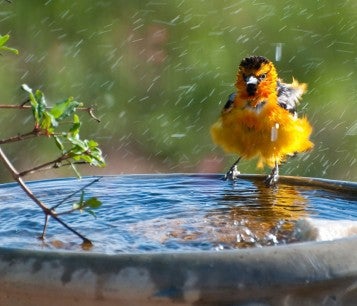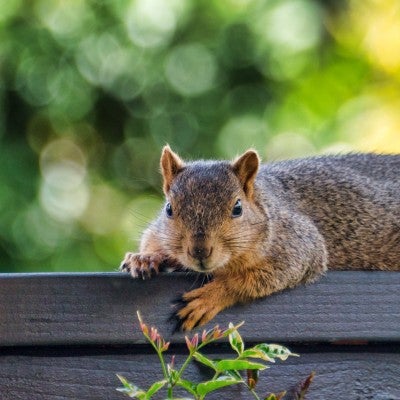There are several species of wild rabbits—most are Eastern cottontail rabbits—who live across most of North America. Cottontails like to live at the edges of open areas. In fact, they are rarely found in dense forests or open grassland.
Contents
No matter how big or small your outdoor space, you can create a haven for local wildlife. By providing basic needs like water, food and shelter, you can make a difference in your own backyard.

Why are there so many rabbits in my neighborhood?
Their love of edges means they love our suburbs. Yards, parks, playgrounds and office parks, often with small natural buffers in between, have lots of edges between small areas of different habitats that rabbits love.
Here today, gone tomorrow is one way to describe rabbits in suburbia. Given the many predators who make meals of rabbits, their populations can rise and fall dramatically over the course of a year. Sometimes, by doing nothing and letting nature take its own course, the homeowner sees the same result as they might from trying to "control" rabbits.
What do wild rabbits eat?
Adult wild rabbits eat clover, grass and other plants, as well as twigs and even bark, if other food sources are scarce. Gardeners may find that rabbits nibble their flower and vegetable plants in spring and summer and the bark of fruit and ornamental trees and shrubs in the fall and winter.
Baby rabbits (kits) will nurse (drink their mother’s milk) during the first few weeks of life and then transition to greens. If you are lucky enough to witness a kit nursing (from a respectful distance), they kick their little legs with joy.
Interestingly, rabbits will excrete, eat and re-digest their own droppings to obtain the maximum amount of nutrients.
How do I keep rabbits from eating my plants?
First things first: Make sure a rabbit is the culprit. Deer eat many of the same things rabbits do and are also common around yards. Twigs browsed by rabbits look neatly clipped but plants browsed by deer appear ragged and torn. You may see the easily recognizable tracks of rabbits in soft soil or snow. And you may see the rabbits themselves—a dead giveaway to their presence—most often near dawn and dusk.
Barriers for flowers and vegetables
A well-constructed fence is the most effective way to protect plants. Two-foot high chicken wire supported by posts every six to eight feet is strong enough to keep rabbits out. Stake the bottom securely to the ground to prevent rabbits from pushing underneath it.
Movable fence panels can protect the garden right after the first planting, when damage is likely to be most severe, and go in the shed the rest of the year. Some years, you won't need the panels at all, given the ups and downs of rabbit populations. New plantings can be protected individually under plastic jugs that have the bottom cut out. These also serve as mini-greenhouses in spring when nights are still cool. Other protection may need to be provided once the jugs come off.
Barriers for trees
Commercial tree wrap or plastic tree guards can keep rabbits from nibbling bark. Cylinders of hardware cloth (stand on their own) or poultry wire (need staking) can work as well. These barriers should be as high as usual snow depth plus eighteen inches. Young trees and saplings are more vulnerable so focus on protecting them.
Rabbits may reach low-hanging branches. A homemade barrier can encircle around them as well. Or prune and leave the trimmings on the ground away from valued trees as a decoy food. Rabbits prefer twigs and buds to the bark of the trunk and will eat these instead if they are easy to reach.
Repellents
In some places, fencing won't be practical or damage will be so slight that a fence isn't cost effective. Then chemical repellents can protect small plots and individual plants. Don't use a repellent on plants that people will eat unless the label specifies it is safe to do so.
Scare devices
Sometimes, scare tape or balloons might frighten rabbits away from an area. The pinwheels sold to repel moles might provide a look scary to rabbits as well.
Habitat modification
Remove cover (vine thickets, tall grass, and shrub cover) around gardens and orchards so rabbits don't have escape cover. They will spend less time—and eat less food—where they feel unsafe. Think, however, about the potential negative effects on other species that could benefit from a naturalized back yard.
How do I know if a rabbit needs help?
Mothers feeds baby rabbits only twice a day—at dawn and dusk. Baby rabbits found alone in a nest are usually not orphans.
Mowing and raking yards can disturb rabbit nests. If a nest has been disturbed, put it back together and cover the babies with the grass that originally covered them. To check if the mother is coming to care for them, place several lengths of yarn or small twigs in a grid pattern over the nest. If the grid is disturbed after the next dawn or dusk, the mother is still caring for the youngsters.
You can prevent harm to baby rabbits by checking your yard carefully for rabbit nests before you mow, especially if you've let the grass grow taller than usual.
Baby rabbits leave the nest when they're 3 weeks old and about the size of a chipmunk. If you find a chipmunk-sized but fully-furred rabbit with eyes open, ears erect and the ability to hop, they are meant to be on their own. As small and helpless as they may look, they are not an orphan and don’t need your help.
Outdoor cats and dogs are a major threat to rabbits. If your pet gets hold of a rabbit, bring your pet inside and find a licensed wildlife rehabilitator or veterinarian. Do not attempt to feed the rabbit; more often than not, this harms them.
How long do wild rabbits live?
As critical members of our ecosystem, rabbits form underground burrows that strengthen our soil health and they serve as a food source for many larger predators. Their valuable place in the food web (as well as human threats such as habitat loss, trapping and cars) means they often don’t live long, but most live somewhere between one and nine years. (Domestic rabbits live about five to 10 years.)
Are wild rabbits a threat to public health?
Rabbits can be infected with tularemia, which may be transmitted to people if they eat undercooked, infected meat or handle a sick animal. Although it's always best not to handle any wild animal, wear gloves if you must handle a wild rabbit and wash your hands thoroughly afterwards.

